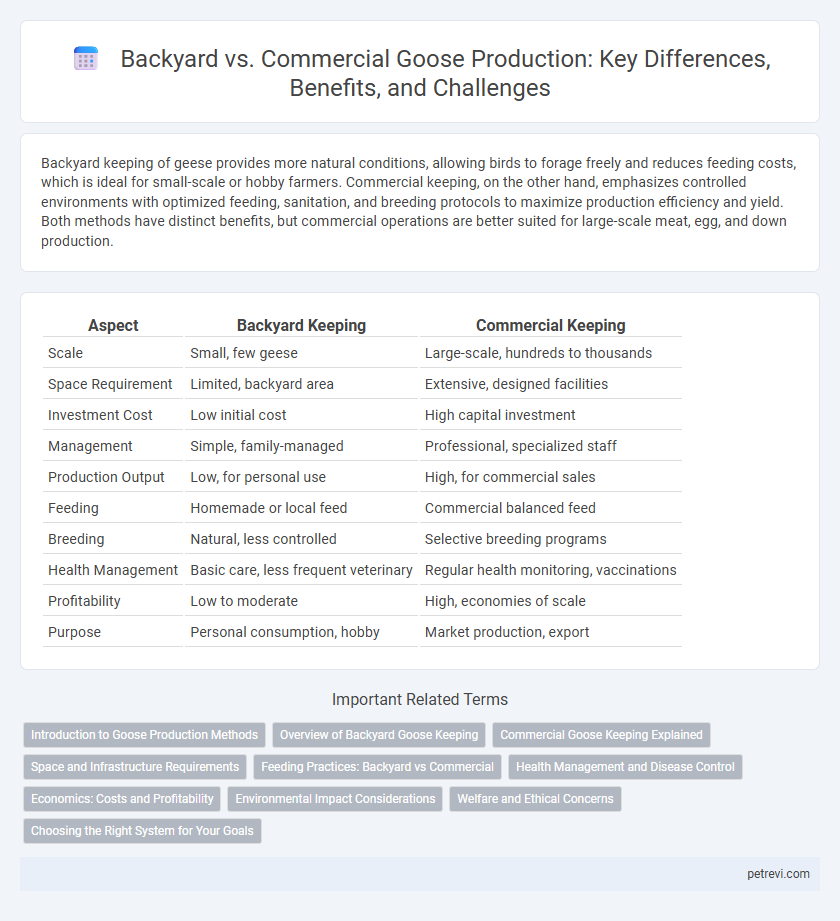Backyard keeping of geese provides more natural conditions, allowing birds to forage freely and reduces feeding costs, which is ideal for small-scale or hobby farmers. Commercial keeping, on the other hand, emphasizes controlled environments with optimized feeding, sanitation, and breeding protocols to maximize production efficiency and yield. Both methods have distinct benefits, but commercial operations are better suited for large-scale meat, egg, and down production.
Table of Comparison
| Aspect | Backyard Keeping | Commercial Keeping |
|---|---|---|
| Scale | Small, few geese | Large-scale, hundreds to thousands |
| Space Requirement | Limited, backyard area | Extensive, designed facilities |
| Investment Cost | Low initial cost | High capital investment |
| Management | Simple, family-managed | Professional, specialized staff |
| Production Output | Low, for personal use | High, for commercial sales |
| Feeding | Homemade or local feed | Commercial balanced feed |
| Breeding | Natural, less controlled | Selective breeding programs |
| Health Management | Basic care, less frequent veterinary | Regular health monitoring, vaccinations |
| Profitability | Low to moderate | High, economies of scale |
| Purpose | Personal consumption, hobby | Market production, export |
Introduction to Goose Production Methods
Backyard goose keeping involves small-scale, low-cost methods where geese are often raised for personal consumption or local sales, emphasizing natural foraging and low-input care. Commercial goose production relies on larger flock sizes, controlled feeding, and specialized housing to maximize meat, foie gras, and feather yields efficiently. Understanding the differences in management, resource allocation, and production goals is essential for selecting the appropriate method in goose farming.
Overview of Backyard Goose Keeping
Backyard goose keeping offers a manageable scale for small producers, emphasizing ease of care, lower initial investment, and opportunities for personal consumption or local sale. Geese in backyard settings require space for grazing, access to water, and protection from predators, making it suitable for hobbyists or those seeking sustainable poultry options. This method contrasts with commercial keeping, where larger flocks demand intensive management, biosecurity measures, and advanced housing systems to maximize production efficiency.
Commercial Goose Keeping Explained
Commercial goose keeping involves large-scale production optimized for maximum yield of meat, feathers, and eggs, utilizing specialized breeds such as Embden or Toulouse geese. Facilities are designed to support high-density populations with controlled feeding, health management, and automated systems to enhance growth rates and product quality. This method contrasts with backyard keeping by emphasizing efficiency, scalability, and market supply consistency in the poultry industry.
Space and Infrastructure Requirements
Backyard goose keeping requires minimal space, often a few hundred square feet per bird, with simple fencing and a small shelter, making it ideal for small-scale hobbyists or families. Commercial goose production demands extensive land, typically several acres to accommodate large flocks, along with robust infrastructure including specialized housing, feeding systems, and waste management facilities to maintain health and productivity. Efficient space utilization and advanced infrastructure in commercial settings enhance growth rates and optimize yield compared to backyard operations.
Feeding Practices: Backyard vs Commercial
Backyard goose keeping relies on natural foraging combined with supplemental grains and kitchen scraps, promoting cost-effective and sustainable feeding practices tailored to small-scale operations. Commercial goose production employs precisely formulated feed mixtures rich in proteins, vitamins, and minerals to maximize growth rates, egg production, and meat quality under controlled conditions. Optimizing feed conversion ratios through balanced nutrition in commercial settings contrasts with the extensive, pasture-based feeding typical of backyard systems.
Health Management and Disease Control
Backyard keeping of geese often involves lower stocking densities, which reduces stress and the risk of disease transmission but may lack structured vaccination programs and biosecurity measures found in commercial operations. Commercial goose production prioritizes rigorous health management protocols, including regular veterinary monitoring, standardized vaccination schedules, and controlled environments to prevent outbreaks of avian diseases such as avian influenza and fowl cholera. Effective disease control in both systems depends on sanitation, proper nutrition, and immediate isolation of sick birds to maintain flock health and productivity.
Economics: Costs and Profitability
Backyard goose keeping involves lower initial investment and operational costs due to limited scale and simple infrastructure, making it suitable for small-scale profit or personal use. Commercial goose production requires higher capital expenditure for specialized facilities, feeding, and labor, but benefits from economies of scale, resulting in greater overall profitability. Efficient feed conversion ratios and market-driven pricing in commercial operations significantly enhance revenue potential compared to backyard setups.
Environmental Impact Considerations
Backyard keeping of geese typically results in lower environmental impact due to minimal resource consumption and natural grazing, which supports soil health and biodiversity. Commercial goose production often requires intensive feed inputs, higher water usage, and generates concentrated waste, leading to potential issues such as nutrient runoff and greenhouse gas emissions. Implementing sustainable practices like managed grazing and waste recycling can mitigate environmental challenges in both backyard and commercial systems.
Welfare and Ethical Concerns
Backyard goose keeping allows for more natural behaviors and individualized care, promoting higher welfare standards through spacious outdoor access and social interaction. Commercial goose production often prioritizes efficiency and high output, which can lead to overcrowding, limited movement, and increased stress, raising significant ethical concerns. Welfare-focused practices in both systems include proper nutrition, health monitoring, and minimizing handling stress to ensure humane treatment.
Choosing the Right System for Your Goals
Backyard keeping of geese offers personalized care with lower initial costs and is ideal for hobbyists or small-scale meat and egg production, emphasizing space efficiency and natural foraging. Commercial keeping requires scalable infrastructure, advanced biosecurity measures, and systematic feeding to maximize productivity and meet market demand, benefiting from economies of scale. Selecting the right system depends on your production goals, available resources, and long-term commitment to managing flock health and output quality.
Backyard keeping vs Commercial keeping for Goose Production Infographic

 petrevi.com
petrevi.com